Uni Kuru Toga
OK, here’s a new one. Fresh out of the postie’s satchel, sent to me by my friend in Japan. I believe it’s a relatively new release on the Japanese market. It is the Uni “Kuru Toga” (M5-450 1P) mechanical pencil by Mitsubishi Pencil. What does Kuru Toga mean? Well, apparently ‘Kuru’ is a sort of Japanese sound symbolism that we don't really have in English, but anyway it's associated with ‘turning’, and ‘Toga’ is the shortened form of ‘togaru’ which means ‘be sharpened’. The pencil itself has 'Kuru Toga Engine' printed on it.
What does Kuru Toga mean? Well, apparently ‘Kuru’ is a sort of Japanese sound symbolism that we don't really have in English, but anyway it's associated with ‘turning’, and ‘Toga’ is the shortened form of ‘togaru’ which means ‘be sharpened’. The pencil itself has 'Kuru Toga Engine' printed on it.  Quite simply, the idea is that as you write the lead is auto-rotated around so that it maintains a sharp point and doesn’t get a chisel edge on it, leading to changing line thicknesses as you write or if you rotate the pencil in your hand. The pencil comes with a 12 page little cartoon style A6 size booklet explaining the virtues of Kuru Toga. Now I don’t read Japanese, so no idea what it actually says, but here it is reproduced in full, so I think we can all get the general idea. I scanned it lay flat, so six scans of A5 size.
Quite simply, the idea is that as you write the lead is auto-rotated around so that it maintains a sharp point and doesn’t get a chisel edge on it, leading to changing line thicknesses as you write or if you rotate the pencil in your hand. The pencil comes with a 12 page little cartoon style A6 size booklet explaining the virtues of Kuru Toga. Now I don’t read Japanese, so no idea what it actually says, but here it is reproduced in full, so I think we can all get the general idea. I scanned it lay flat, so six scans of A5 size. 




 I haven’t pulled the mechanism apart but clearly the concept is that the lead-holding jaws are mounted on a toothed clutch. Each time you press down to write the clutch teeth engage and the sliding faces cause the lead to be rotated around a fraction.
I haven’t pulled the mechanism apart but clearly the concept is that the lead-holding jaws are mounted on a toothed clutch. Each time you press down to write the clutch teeth engage and the sliding faces cause the lead to be rotated around a fraction.  The trick then is the constant lifting and pressing back down as you write. The clutch is springing apart and back together, rotating each time. Now this is a 0.5mm pencil, so a chisel edge on the lead isn’t a huge deal, but still, it’s a heck of an idea. There is also a 0.3mm version. Now that would be a sharp point! Still, Uni extol the virtues of the constantly sharp point for neat precise writing, and a reduction in lead breakage.
The trick then is the constant lifting and pressing back down as you write. The clutch is springing apart and back together, rotating each time. Now this is a 0.5mm pencil, so a chisel edge on the lead isn’t a huge deal, but still, it’s a heck of an idea. There is also a 0.3mm version. Now that would be a sharp point! Still, Uni extol the virtues of the constantly sharp point for neat precise writing, and a reduction in lead breakage.Right then. Does it actually work?
Well… yes, it does. Whether you really care, well…that’s another matter.
So, first thing I did was get an ordinary pencil (Lamy 2000) and the Kuru Toga and make sure they had good clean leads with a square end. Start writing. Clearly normal started out a thin line and got progressively thicker as the end wore down to a chisel point. I did not rotate the pencil in my hand. The picture below shows ‘normal’ at the start and then ‘normal’ after a line of writing. At the bottom of the picture are three lines – the middle one is at the start, the one above and below are after the chisel edge has been worn on the lead. So, we can see what happens normally, things get thicker as the lead wears. (Phew, it's like rocket-science)
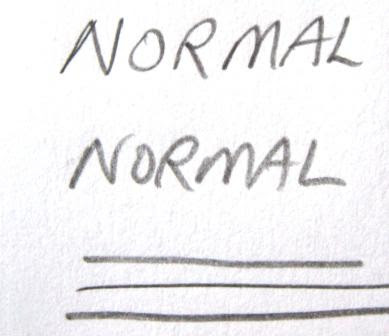 Now Kuru Toga. Below is a picture of ‘normal’ and ‘kuru’ after a couple of lines writing with each. Normal has worn to a chisel point and makes thicker lines. Kuru stays sharp.
Now Kuru Toga. Below is a picture of ‘normal’ and ‘kuru’ after a couple of lines writing with each. Normal has worn to a chisel point and makes thicker lines. Kuru stays sharp. To recap – here’s the 3 line test for both, shown together. For each, the middle line is the start with a fresh new lead, the lines above and below are drawn after a couple of lines of writing with that lead.
To recap – here’s the 3 line test for both, shown together. For each, the middle line is the start with a fresh new lead, the lines above and below are drawn after a couple of lines of writing with that lead. One thing I did note with Kuru Toga was that it always felt slightly scratchy on the paper. You know how when you pick up a pencil and by chance you start writing with the sharp side or tip of the chisel point and it digs or catches a little on the paper. Well, that’s basically what kuru is doing, always presenting the sharp edge to the paper, so it’s not the smoothest of writing experiences. Still, nothing to get too hung up over.
One thing I did note with Kuru Toga was that it always felt slightly scratchy on the paper. You know how when you pick up a pencil and by chance you start writing with the sharp side or tip of the chisel point and it digs or catches a little on the paper. Well, that’s basically what kuru is doing, always presenting the sharp edge to the paper, so it’s not the smoothest of writing experiences. Still, nothing to get too hung up over.You know, to some extent it almost doesn’t matter how well this pencil works or not, it’s the thought that counts. These sorts of ideas and innovations are occurring in Japan, not elsewhere. Just look at that booklet! This is clearly the product of a design team and company that really think about their product and their market, see a future, try something new, move forward, and not just think, “Oh, it’s a pencil, we’ll always sell them, but there’s nothing much ever going to happen with pencils! They’re a cash-cow, just milk them.”
Link to the new Uni Kuru Toga High Grade

 “Koh-I-Noor, Made by L & C Hardtmuth In Austria” and on the other side “2B, British Graphite Drawing Pencil, Compressed Lead”. So, it’s British yet made in Austria? I wonder if they mean the graphite came from Britain?
“Koh-I-Noor, Made by L & C Hardtmuth In Austria” and on the other side “2B, British Graphite Drawing Pencil, Compressed Lead”. So, it’s British yet made in Austria? I wonder if they mean the graphite came from Britain?
 “Berol, EAGLE JEANS, USA, HB, 2”. The paint finish appears to be an attempt to imitate denim fabric, as in a pair of blue jeans.
“Berol, EAGLE JEANS, USA, HB, 2”. The paint finish appears to be an attempt to imitate denim fabric, as in a pair of blue jeans.  A square unpainted, unmarked, raw pencil.
A square unpainted, unmarked, raw pencil.

 No photo because its gold on yellow and so doesn't really show up, but a Made in Bavaria Swan Manifold Ink Pencil.
No photo because its gold on yellow and so doesn't really show up, but a Made in Bavaria Swan Manifold Ink Pencil. The first few letters of the marking have been sharpened off, but reconstructed it would apparently read, “Creta Laevis, E Wolff & Son, Inventors, London, (the colour)”. The colours I have are Green No 1, Green No 3, Olive Green, Sepia No 1 and Bn Pink. The web seems strangely silent on these Creta Laevis, but apparently they are a sort of pastel pencil. Anyone know anything interesting about them? Are they still made, etc?
The first few letters of the marking have been sharpened off, but reconstructed it would apparently read, “Creta Laevis, E Wolff & Son, Inventors, London, (the colour)”. The colours I have are Green No 1, Green No 3, Olive Green, Sepia No 1 and Bn Pink. The web seems strangely silent on these Creta Laevis, but apparently they are a sort of pastel pencil. Anyone know anything interesting about them? Are they still made, etc? Note how the core does not go through to the end of these Creta Laevis pencils, unlike their graphite cousins to the right in the photo. I guess if the pastel core is expensive, it makes sense for it to stop a little short of the end so that none of the core is wasted when the pencil becomes too short.
Note how the core does not go through to the end of these Creta Laevis pencils, unlike their graphite cousins to the right in the photo. I guess if the pastel core is expensive, it makes sense for it to stop a little short of the end so that none of the core is wasted when the pencil becomes too short. 


 Woo-hoo! The Caran d’Ache
Woo-hoo! The Caran d’Ache  So, the nice rosewood glass-topped presentation box contains a 2mm clutch pencil - the silver-plated rhodium coated, chevron pattern Ecridor Fixpencil.
So, the nice rosewood glass-topped presentation box contains a 2mm clutch pencil - the silver-plated rhodium coated, chevron pattern Ecridor Fixpencil.  You also get an eraser, a set of coloured leads and an art booklet.
You also get an eraser, a set of coloured leads and an art booklet. The set of leads is one each of red, blue, green and yellow. Even better, they are actually aquarelles, or watercolour leads. So you use them like normal coloured leads, but also you can brush or wash them over with water to blend and create new colours. The little booklet tells you all about the various different techniques.
The set of leads is one each of red, blue, green and yellow. Even better, they are actually aquarelles, or watercolour leads. So you use them like normal coloured leads, but also you can brush or wash them over with water to blend and create new colours. The little booklet tells you all about the various different techniques. 
 It appears though that I have some way to go before my first exhibition.
It appears though that I have some way to go before my first exhibition. 
 I also bought a set of ordinary graphite leads too.
I also bought a set of ordinary graphite leads too.  The eraser is rather impressive. Far too good looking to actually use, so no idea how well it really works.
The eraser is rather impressive. Far too good looking to actually use, so no idea how well it really works.
 So as well as being a review, the outlook for the PG1505 is perhaps not all that rosy, so this all has a hint of eulogy and obituary about it.
So as well as being a review, the outlook for the PG1505 is perhaps not all that rosy, so this all has a hint of eulogy and obituary about it.  At first glance the PG1505 is a rather long, slender shaped pencil. The serious ‘technical aura’ is enhanced by the simple colour scheme of black and silver. The styling of this pencil has always reminded me of a long thin tapering calligraphy brush, and I’ve always thought that was appropriate for one of Pentels finest - I like to imagine that the Japanese calligraphy tradition played some role in inspiring the styling of this pencil.
At first glance the PG1505 is a rather long, slender shaped pencil. The serious ‘technical aura’ is enhanced by the simple colour scheme of black and silver. The styling of this pencil has always reminded me of a long thin tapering calligraphy brush, and I’ve always thought that was appropriate for one of Pentels finest - I like to imagine that the Japanese calligraphy tradition played some role in inspiring the styling of this pencil. As a serious draughting pencil of considerable lineage, the PG1505 has many classic features. Starting at the tip, this is a 0.5mm lead diameter pencil and you will not be surprised to find we have a 4mm fixed sleeve. In the past, a couple of readers have raised the issue of “lead wobble” inside the sleeve. Well, I can assure you there is none with this pencil. The lead is rock solid inside that sleeve. Obviously though a long fixed lead sleeve makes this pencil pocket unsafe. Actually if you take the overall look of this pencil into account it’s sort of a mini-javelin so maybe I should rate it as super-pocket unsafe?
As a serious draughting pencil of considerable lineage, the PG1505 has many classic features. Starting at the tip, this is a 0.5mm lead diameter pencil and you will not be surprised to find we have a 4mm fixed sleeve. In the past, a couple of readers have raised the issue of “lead wobble” inside the sleeve. Well, I can assure you there is none with this pencil. The lead is rock solid inside that sleeve. Obviously though a long fixed lead sleeve makes this pencil pocket unsafe. Actually if you take the overall look of this pencil into account it’s sort of a mini-javelin so maybe I should rate it as super-pocket unsafe? Moving on up from the sleeve the next feature of significance is the knurled grip. This of course provides excellent non-slip grip, but sometimes I did pick up a hint of roughness. Of course you must remember that I’m just an office-wallah, not a thick-skinned toughened engineer or mega-structure architect who would laugh at such lily-livered sensitivities. The grip is not a particularly large diameter so might not suit all. The grip and other componentry give this pencil a slightly tip-heavy balance point, but not so much that the tapering upper body feels like its flapping around in the wind. So, well balanced and weighing in at 21 grams, the PG1505 feels reasonably substantial in the hand.
Moving on up from the sleeve the next feature of significance is the knurled grip. This of course provides excellent non-slip grip, but sometimes I did pick up a hint of roughness. Of course you must remember that I’m just an office-wallah, not a thick-skinned toughened engineer or mega-structure architect who would laugh at such lily-livered sensitivities. The grip is not a particularly large diameter so might not suit all. The grip and other componentry give this pencil a slightly tip-heavy balance point, but not so much that the tapering upper body feels like its flapping around in the wind. So, well balanced and weighing in at 21 grams, the PG1505 feels reasonably substantial in the hand.
 Overall then this is an excellent pencil and I’m sorry to see it gone from Pentels general international range.
Overall then this is an excellent pencil and I’m sorry to see it gone from Pentels general international range.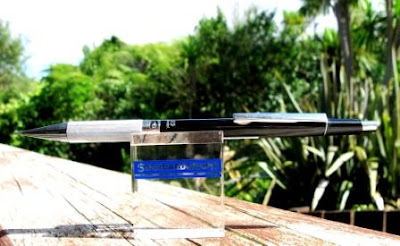

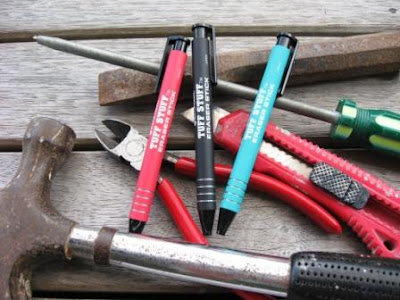 Well first off the Tuff Stuff seems a fairly typical mechanical stick eraser. Just like many a mechanical pencil, you push the top to advance the lead, oops, sorry, the eraser core, and you can push the core back inside the tip if necessary. I think this eraser stick counts as “pocket-safe”. The pocket clip top section pulls off to allow refilling with another eraser core. I’m not completely convinced by the security of the top section to the main body and I could imagine it coming loose after much use, but then this is not an expensive item , so just get another one if that ever happens.
Well first off the Tuff Stuff seems a fairly typical mechanical stick eraser. Just like many a mechanical pencil, you push the top to advance the lead, oops, sorry, the eraser core, and you can push the core back inside the tip if necessary. I think this eraser stick counts as “pocket-safe”. The pocket clip top section pulls off to allow refilling with another eraser core. I’m not completely convinced by the security of the top section to the main body and I could imagine it coming loose after much use, but then this is not an expensive item , so just get another one if that ever happens.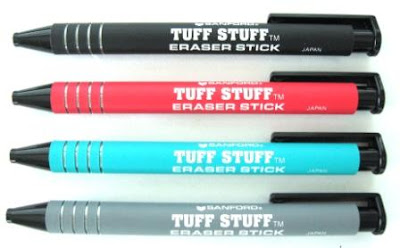 Now, the main event, the eraser core. Well it’s fairly narrow for a stick eraser, just under 4mm diameter (a bit over 1/8 inch). Mark pointed out to me that this diameter fits several mechanical pencil eraser cartridges (e.g. Faber-Castell). The compound appears to be a fairly hard vinyl, but don’t take the “vinyl” bit as gospel. I have noticed a bit of a general trend for eraser compounds to get harder as their diameter decreases, which does have some logic to it. Being a fairly narrow diameter the Tuff Stuff is well suited to smaller more precise erasing jobs, e.g. rubbing out an individual letter as opposed to whole lines of wording. The waste doesn’t readily twist up into strands so it’s a little messy, particularly on larger jobs. The eraser core often ends up with a dirty half-rubbed off stringy-blobby bit stuck on its tip (yes, that’s a technical term), which rather irritates me. (Dreadlocks for erasers?)
Now, the main event, the eraser core. Well it’s fairly narrow for a stick eraser, just under 4mm diameter (a bit over 1/8 inch). Mark pointed out to me that this diameter fits several mechanical pencil eraser cartridges (e.g. Faber-Castell). The compound appears to be a fairly hard vinyl, but don’t take the “vinyl” bit as gospel. I have noticed a bit of a general trend for eraser compounds to get harder as their diameter decreases, which does have some logic to it. Being a fairly narrow diameter the Tuff Stuff is well suited to smaller more precise erasing jobs, e.g. rubbing out an individual letter as opposed to whole lines of wording. The waste doesn’t readily twist up into strands so it’s a little messy, particularly on larger jobs. The eraser core often ends up with a dirty half-rubbed off stringy-blobby bit stuck on its tip (yes, that’s a technical term), which rather irritates me. (Dreadlocks for erasers?)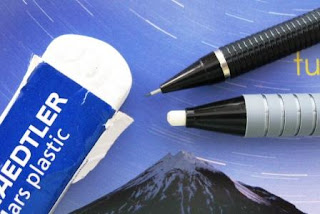
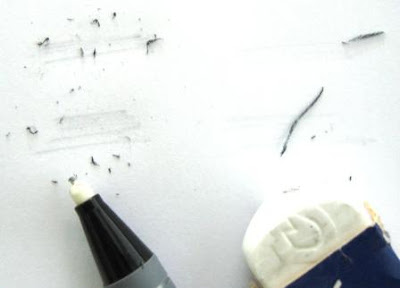 Overall then, I do like this eraser, but to date, Mars Plastic plus an eraser shield remains virtually unbeatable.
Overall then, I do like this eraser, but to date, Mars Plastic plus an eraser shield remains virtually unbeatable.




